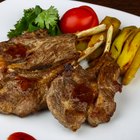
The beef shoulder, or chuck, is made up of a group of well-used muscles that tend to be tough and stringy. Chuck cuts are popular in spite of this, because their toughness is matched by their rich, beefy flavor. When slow cooked for stew or pot roast, these relatively inexpensive cuts can make a memorable meal. The petite tender is an exception to these rules. It's a small piece of very tender muscle that's cut from the full shoulder, and sold for grilling or quick roasting.
What It Is
The petite tenderloin is a small muscle located on the outside of a steer's shoulder, where it acts primarily as a placeholder supporting other muscles. It's known to specialists as the teres major muscle, and it's one of the tenderest on the entire animal. Like the larger and better-known tenderloin, it's very lean and free of gristle or connective tissue. Given that fat, toughness and connective tissue are the three things that make a cut suitable for slow cooking, the petite tender is a poor choice for most slow-cooking methods.
Very Slow Cooking
The exception is a few styles of very low temperature cooking, including slow-roasting and water bath, or "sous vide," cooking. When meats are cooked at very low temperatures, the proteins that make up the muscle tissue gently become firm without ever contracting and toughening, as they would at high heat. Slow roasting takes place at temperatures as low as 225 degrees Fahrenheit, and sous vide cooking can be even lower. These techniques yield a very tender, juicy petite tenderloin, but it lacks the savory flavors of high-temperature grilling or broiling. Most chefs compensate by quickly browning the outer surfaces either before or after the slow-cooking process.
Grilling, Broiling and Pan-Searing
An individual petite tenderloin averages around 10 ounces, suitable for one large appetite or two smaller portions. They can be grilled or broiled while, or sliced into thick medallions for grilling, broiling or pan-searing. Chefs generally cook petite tenders at a very high temperature to sear or even char the outer surface, while warming the interior to rare or medium-rare. If the tender is cooked whole, it's then sliced crosswise to create serving portions. Grilled or broiled medallions, like filet mignon, are usually plated one or two at a time with a suitable sauce and side dishes.
Roasting
The petite tenderloin also lends itself well to use as a small, upscale roast, similar in weight to a pork tenderloin but slightly wider and flatter in shape. It can be crusted with fresh-cracked pepper or a mixture of herbs and breadcrumbs, if you wish, or simply seared ahead of time in a hot skillet. Roast the petite tender at 425 F until it reaches your desired degree of doneness. A small petite tender cooked to rare might require as little as 15 minutes, while a larger tender cooked to medium-rare might take as long as 25 minutes. Let the tenderloin rest for at least 5 minutes before carving it.
Related Articles

What Are Pork Cutlets?
How to Cook a Spencer Roast

How to Cook 5 Lbs. of Beef Tenderloin
How to Cook Boneless Lamb Butterflied ...

Different Cuts of Steak

What Is a Chateau Cut?

How to Slow Cook a Tri-Tip on the ...
What Part of the Cow Is Boneless Beef ...

How to Make a Blackbuck Antelope Roast

How to Grill a Lamb Steak

Extracting Bone Marrow for Cooking

Slow Roasting a Leg of Lamb Until It Is ...

Does a Rib Eye Have a Filet in It?
How to Cook Buffalo Fillet

Rib Vs. Loin Grilled Lamb Chop

Brisket vs. Tri-Tips

How to Cook a Small Lamb Shoulder

How to Julienne Fennel

How to Cook a 15-Pound Rib Roast

How to Cook Veal Leg Scallopini
References
Resources
Writer Bio
Fred Decker is a trained chef and prolific freelance writer. In previous careers, he sold insurance and mutual funds, and was a longtime retailer. He was educated at Memorial University of Newfoundland and the Northern Alberta Institute of Technology. His articles have appeared on numerous home and garden sites including GoneOutdoors, TheNest and eHow.
Photo Credits
John Foxx/Stockbyte/Getty Images